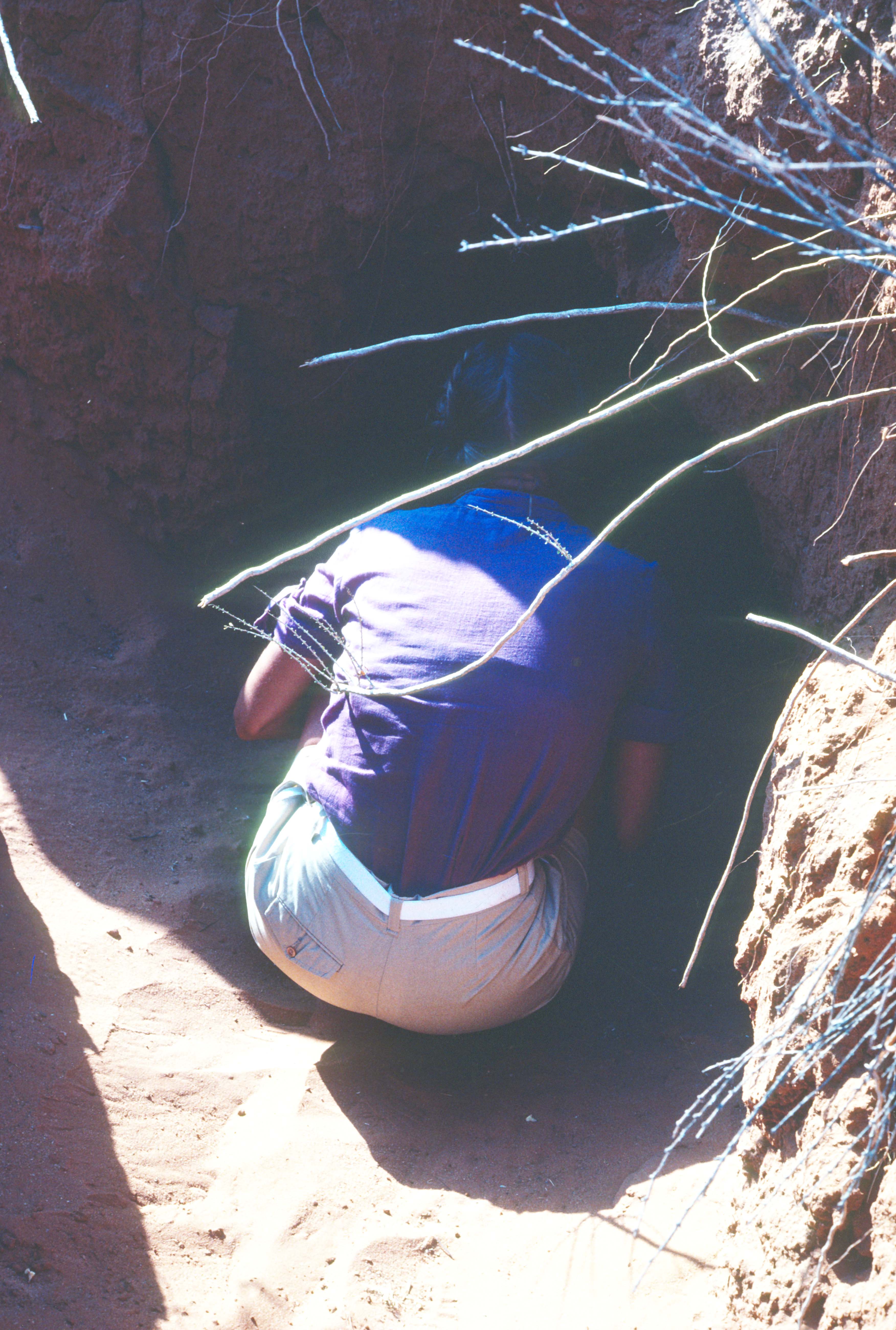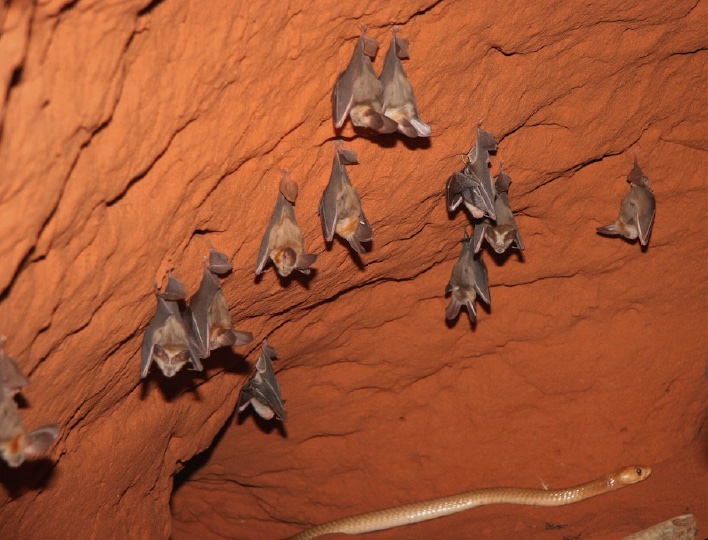24 Avoiding encounters in aardvark burrows
“In another moment down went Alice after it [the rabbit], never once considering how in the world she was to get out again.” – Lewis Carroll, Alice’s Adventures in Wonderland
Some physical features in the environment are decidedly magnetic to particular people. Mountain tops or steep rocks elevate climbers. Rushing streams catch and sometimes release fishermen and kayakers. Surf seduces surfers. Coral reefs are an undertow to snorkelers and scuba divers.
Aardvark (and porcupine) burrows are common in parts of Africa, but are magnetic only to select individuals. Carolyn is a charter member of that group, which must be tiny. In fact, I have never met anyone else who shares this subterranean attraction.
Aardvarks are found only in Africa. These nocturnal mammals weigh about 60 to 80 kg and are built low to the ground. “Aardvark” is Afrikaans for “earth pig,” a name that fits. OK, they are unrelated to pigs, but they have a long pig-like snouts, which they use to sniff out ants and termites, their favorite foods. Aardvarks are champs at digging extensive burrows, and some people claim that aardvarks can out-dig humans equipped with hand-shovels. If want to see aardvark in action, check this video.] African porcupines also dig large burrows in the Kalahari.
Before returning to Carolyn’s misadventures in wonderland, I first digress about aardvark burrows. I myself have no desire to enter one, but I do find them conceptually interesting, especially after reading a Master of Science thesis by Gareth Morgan Whittington-Jones (2006) from Rhodes University, South Africa.
Whittington-Jones addressed whether aardvarks could be considered “ecosystem engineers,” a jargon term that has become popular among ecologists in recent decades. For an organism to earn a merit badge in ecosystem engineering, it must physically not only alter the structure of its environment, but do so with sufficient impact to influence the ecology of other organisms in the system.
Humans are the paradigmatic EEs (however, we might be better described as ecosystem eliminators). Elephants, beavers, gophers, corals, and termites are familiar examples. Whether ecosystem engineers are beneficial or destructive depends on your point of view. Frogs and trees have different perspectives on beavers.
Aardvarks dig several types of burrows, but their main ones are up to 13 meters long and wide enough for an adult human to enter – should an ‘adult’ human be so possessed. Aardvarks aren’t exclusive occupants of their burrows: Whittington-Jones found 25 mammals, seven birds, one amphibian, and six reptiles in burrows.
Aardvark burrows affect the ecology of other organisms in three ways: they provide a retreat, serve as seed reservoirs, and enhance soil turnover and decomposition. Whittington-Jones concluded that aardvarks qualify as “ecosystem engineers.” [Note: For someone driving cross country in the veld, aardvark burrows can effectively and rapidly engineer the destruction of a vehicle.]
We encountered a live aardvark first in 1981 (my third trip to Africa and Carolyn’s second). En route to the Kalahari, we visited the Masai Mara Reserve in the Serengeti of Kenya. We stayed with Lawrence Frank, a UC Berkeley biologist who was doing pioneering work on the behavior and ecology of spotted hyenas. Lawrence had night-vision goggles – a new technology at the time. Much to our delight, he invited us to join him on his nocturnal forays, following hyenas through the night. Only one of us could join him on a given night. I went first. Carolyn second.
When Carolyn and Lawrence returned to camp late at night, they were excited. They’d seen and followed a live aardvark. Lawrence jumped out of his Land Cruiser and heroically ‘counted coup’ (that is, touched the aardvark’s rump) when the aardvark started digging an escape burrow!
I was happy for Carolyn but painfully envious. I’d spend almost a year in the Kalahari, but the only aardvark I’d seen was a DOR (dead on the road). I selfishly wished that Carolyn and I had switched nights but was still glad that Carolyn got to see a live one – up close and personal.
I recovered from the sin of envy when we arrived in the Kalahari a few weeks later. In Masai Mara, one didn’t walk about in the veld but could in the Kalahari. When we encountered an aardvark/porcupine, Carolyn immediately announced that she would explore it – this would require crawling into the burrow on her knees.

I knew that Carolyn hadn’t thought this through. Yes, she was physically slim enough to crawl down and explore the hole, but I rather suspected that she (like Alice) hadn’t considered what she would do if she encountered an aardvark or other critters during her exploration. In all honesty, I had never explored an aardvark burrow. Still, my biological intuition suggested rather strongly that various nasty creatures (scorpions, snakes, etc.) might use those burrows as retreats.
Furthermore, the aardvark responsible for the engineering wonder might even be at home, and I really didn’t want to contemplate what might happened if one encountered an aardvark down a multi-meter burrow. How might the beast respond to an uninvited guest?
Anyway, I told her rather abruptly. “No, do not go down that burrow!” I probably added “You’d be nuts,” or a more colorful equivalent – but I hope not.
Fortunately, Carolyn didn’t crawl down that burrow, though she was irritated by my resistance. Not surprisingly, we have repeated this scene a few other times our wanderings in the Kalahari, always with the same outcomes.
Later that trip, we had the good fortune of meeting Gus and Margie Mills, who were studying brown hyaenas in the Kalahari. Like ‘Lawrence (Frank) of Masai Mara,’ Gus and Margie had night vision goggles. They would drive out many nights and follow the brownies, recording their movements and activities, as they later described in their fascinating book, Hyaena Nights.
Margie graciously stayed home two nights so that Carolyn and I could go out with Gus. No aardvarks this time, but we both had exciting memories of driving across the dunes, following brownies, and hearing rifle-shot crunches when the brownie’s teeth shattered a dried leg bone of a scavenged animal. The sound was sharp, loud, and caused me to think back on Patti Moehlman’s parting words (Chapter 15) before I left for my first trip to Africa.
We must have told Gus and Margie about Carolyn’s compulsion to explore aardvark burrows because I received an email from Gus around 2008. He and Margie were back in the Kalahari, this time studying cheetahs. Here is the text of Gus’s email, describing an experience he had just had, while following on foot a cheetah’s spoor.
“We were tracking a cheetah when we came across a large hole. We heard a strange sort of fluttering noise coming from inside so I decided to investigate. I crawled into the hole and around the first corner found about 50 Egyptian slit faced bats roosting in the tunnel. I took a few pictures in the dark with only a small torch for focusing. When I downloaded the photos I was interested to see that I had been sharing the experience with another animal which I had not seen!”
Gus attached the photo to his email. The image was clear – clear enough not only to see the bats, but also something else, namely, a cape cobra at the back of the burrow. (Cape cobras, as should be obvious, are very deadly.)

Gus immediately fired off the email and photo to me and suggested wryly that Carolyn might want to look at his photo!
Of course, I immediately forwarded Gus’s email (with total glee, I confess) to Carolyn. It does feel good to be so right in an argument, especially one that had been repeated almost every time we encountered an aardvark burrow! Carolyn conceded that I’d been right – at least once. But I’m sure she did so with regret.
Then in February 2014 we were finally back in the Kalahari. Sadly, Gus and Margie had left, but our desert was still there. In our wanderings about, looking for lizards, we spotted several aardvark/porcupine burrows. Carolyn retained her urge to crawl down them. I of course gently reminded her of Gus’s photo. We had reached a stable equilibrium.
One lesson in life that emerges from this set of experiences is this: urges provide the motivation that is necessary to try new things or to challenge ourselves. Even so, urges – however strongly felt – aren’t always smart to follow. Bertrand Russell said it well: “A life without adventure is likely to be unsatisfying, but a life in which adventure is allowed to take whatever form it will is sure to be short.”
A second lesson comes to my mind, namely, that my own advice is wise and should always be taken. But presenting that lesson in public might be seen as egocentric what is worse, Carolyn and perhaps others might counter with conflicting evidence.